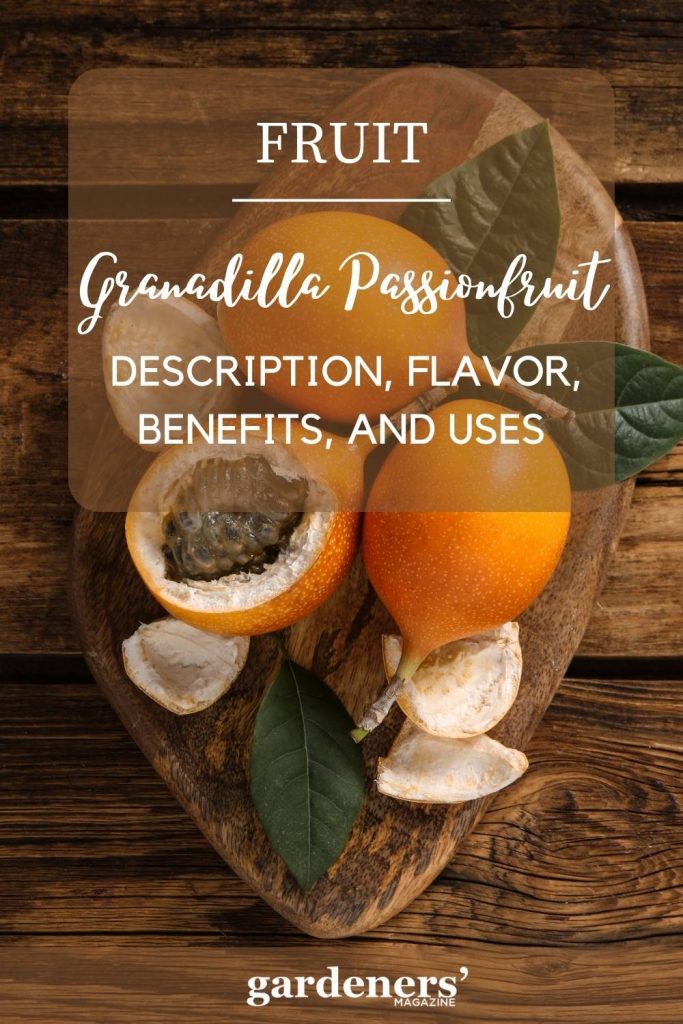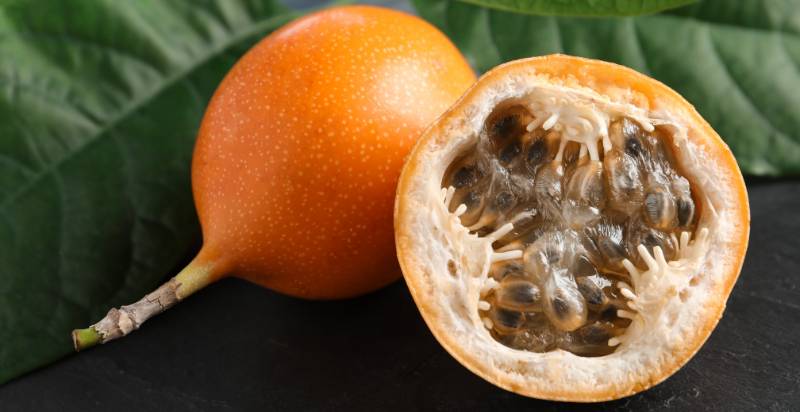Granadilla Passionfruit is one of South America’s most popular and beloved fruits, particularly in Brazil, Colombia, Peru, Venezuela, and Argentina. It is related to the common passionfruit but has a unique sweet-tart flavor that makes it highly sought after. In addition to its delicious taste, Granadilla Passionfruit contains numerous vitamins and minerals that make it a healthy snack. Below, we’ll explore the nutrition facts and health benefits of Granadilla Passionfruit.
What is Granadilla Passionfruit?
Granadilla passionfruit is tropical, known as the “sweet granadilla” or “giant granadilla.” It is native to South America and a member of the Passifloraceae family. It is an edible species of passionfruit with large yellow-orange fruits and sweet, juicy flesh.
Granadilla passionfruit is known for its succulent texture and unique flavor, making it incredibly popular in the culinary world. The fruit is often used in salads, smoothies, and desserts to add a sweet-tart flavor. It can also be used to make juice or jams, and preserves. The ripe fruit can be eaten raw or cooked, and the seeds are edible.

History and Origin of Granadilla Passionfruit
Granadilla passionfruit, also known as Passiflora edulis, has a long and varied history. Its origins are likely in South America, primarily Brazil and Peru, where it has been cultivated for centuries. It was once classified as a species of the Passiflora genus but has recently been reclassified as its own genus. Granadilla is derived from the Spanish word “Granada,” which means pomegranate.
Granadilla passionfruit was first introduced to Europe in the late 19th century and is now widely grown in the Mediterranean, Africa, and Asia. In some parts of South America, it is even used as an ingredient in alcoholic beverages. This passionfruit is an important crop for farmers in many parts of the world due to its popularity and high yields.
Description of Granadilla Passionfruit
Granadilla passionfruit is a tropical fruit that grows on a vine and has an oval shape. It typically ranges from 5 to 10 cm long and has thin, leathery skin featuring deep wrinkles. The flesh of the granadilla is yellow-orange and contains small black seeds. It is juicy, sweet, and flavorful and can be eaten raw or used to make jams, jellies, and other sweet treats. The skin and seeds are not usually consumed, as they can be bitter.
Flavor Profile of Granadilla Passionfruit
Granadilla passionfruit is a highly aromatic fruit with an intense, sweet-tart flavor. Its bright yellow skin contains an abundance of juicy flesh filled with edible black seeds. The flavor mixes tart pineapple, sweet strawberry, and floral honeydew melon. Its sweet yet tangy taste works well in both savory and sweet applications, making it a popular choice in sauces, cocktails, desserts, and more.
While its flavor is usually appreciated on its own, it pairs particularly well with citrus fruits such as lemon and lime and other tropical fruits like mango, guava, and papaya. Granadilla passionfruit is also a great way to add an exotic flavor to salads, ice creams, and smoothies.
Seasonality and Availability throughout the year of Granadilla Passionfruit
Granadilla Passionfruit is mainly available throughout the year, but its peak season is summer. The flesh of this tropical fruit has a sweet and tart taste, making it a popular item in many local markets. During June, July, and August, when Granadilla Passionfruit is at its freshest and most flavorful, it can be found in abundance in most places.
Granadilla Passionfruit is harvested in some areas during the fall and winter months, although its peak season remains June through August. During these months, prices tend to be lower, and the fruit’s flavor is more intense than at other times of the year. The exact timing of the harvest also depends on the region where it is grown.
Health Benefits of Granadilla Passionfruit
Granadilla passionfruit is a nutrient-rich tropical fruit that can provide numerous health benefits. It contains antioxidants, fiber, vitamins, and minerals that may help boost immunity, improve digestion, reduce inflammation, and enhance eye health. Additionally, Granadilla passionfruit has been associated with helping manage diabetes and lowering cholesterol levels.
Furthermore, the high vitamin C content in the fruit can help protect against free radicals and may reduce the risk of certain types of cancer.
Additionally, consuming Granadilla passionfruit can aid digestion and weight loss due to its high fiber content. Finally, it can also help improve skin health and help maintain healthy hair due to its vitamin C content. All these benefits make Granadilla passionfruit an ideal addition to any healthy diet.

Cultivation of the Granadilla Passionfruit
Granadilla passionfruit is a subtropical perennial vine. It needs warm temperatures and plenty of sunlight to grow and thrive. Plant the vines in well-drained soil, at least 15 cm deep. Add organic matter such as compost or manure to the soil before planting. Vines should be spaced at least 1 meter apart in rows 3 meters apart.
When the vines are established, prune them to keep a single main stem and remove all lateral branches. Fertilize regularly with a balanced fertilizer such as 10-10-10 during the growing season. Water regularly so that the soil stays moist but not soggy. Keep weeds away from the base of the vines to reduce competition for nutrients and water.
Granadilla passionfruit also needs regular pest management throughout its growing season. Common pests include aphids, mites, mealybugs, and whiteflies. Monitor your plants closely for any signs of infestation and take appropriate action quickly. Remove all debris from the area to reduce the habitat for pests in the future. Use organic pesticides such as neem oil or insecticidal soap to treat an infestation if necessary.
Harvesting of the Granadilla Passionfruit
The Granadilla Passionfruit harvest should occur when the fruit is 2-3 cm in diameter, with a firm feel and a yellowish tint. Fruits that are too ripe (soft) may not ship or store well. The optimal time for harvesting can vary depending on local environmental conditions such as temperature, rainfall, and sunshine levels, which affect ripening times.
Generally, in warmer climates, fruit is ready for harvesting 6-8 weeks after flowering, and in cooler climates, 8-12 weeks may be required. Hand-picking or mechanical methods can be used to harvest the fruit. It is important to pick the fruits carefully, as bruising will reduce their shelf life.
Where does Granadilla Passionfruit Grow?
Granadilla passionfruit is widely grown in tropical and subtropical regions around the world. It is grown extensively in Colombia, Ecuador, Peru, and Brazil in Latin America. It is also found growing in tropical Africa, including Kenya, Tanzania, Zimbabwe, Madagascar, South Africa, and parts of Asia, such as India and Sri Lanka.
The United States of America is the largest producer of this fruit, with major production happening in Florida and California. In Australia, it’s widely grown in Queensland and New South Wales. It’s also growing in other parts of the world, such as Israel, Italy, Mexico, and Morocco.
What are the things to remember when buying Granadilla Passionfruit?
- Make sure that the Granadilla Passionfruit you buy is freshly picked from a reputable source.
- Choose fruit with bright yellow skin and no blemishes or brown spots on it, as these are signs of over-ripeness or damage to the fruit.
- Look for firm, pliable fruits – too hard and the fruit won’t be sweet enough – too soft and likely over-ripe.
- To get the best flavor, use the passionfruit within two to three days of purchase.
- When buying pre-packaged Granadilla Passionfruit, check the packaging for any signs of leakage or damage, as this could indicate that the fruit has gone off.
These are some of the things to keep in mind when buying Granadilla Passionfruit.
What is the best way to Store Granadilla Passionfruit?
Granadilla passion fruit should be stored in a cool, dry place away from direct sunlight. Keeping the fruit at temperatures between 45-50°F (7-10°C) is best. Refrigeration can also help extend the shelf life of this passionfruit. When storing whole fruits, ensure they are placed in a shallow container lined with paper towels and kept between 32-41°F (0-5°C). Consuming the fruit within 7-10 days is best for optimal flavor.
If you need to store it for longer, you can freeze the fruit, as frozen Granadilla passionfruit will last up to 12 months. For best results, wrap the fruit in a plastic bag before freezing. You can also make jam or juice with Granadilla passionfruit and store it for up to a year.
How can Granadilla Passionfruit be used in recipes with other Fruits and Vegetables?
It can be used in various recipes with other fruits and vegetables. It pairs especially well with tropical fruits like mango, pineapple, and banana. Some popular recipes include smoothies with Granadilla Passionfruit as the main ingredient; granola bowls that incorporate Granadilla Passionfruit; salads mixed with Granadilla Passionfruit and other vegetables; and even desserts like ice cream with Granadilla Passionfruit sauce. Additionally, the juice of the Granadilla Passionfruit can be a great addition to juices and cocktails.
When using Granadilla Passionfruit in recipes, it’s important to remember that its exterior can be tough and leathery, so it’s usually best to scoop out the flesh. Furthermore, you may want to strain the juice if any seeds are present. Finally, Granadilla Passionfruit tends to be on the tart side, so adjust other ingredients accordingly or add some sweetener like honey or sugar to balance the flavor.
Conclusion
Granadilla Passionfruit is an exotic fruit native to South America with a unique flavor profile. It can be enjoyed in raw form or added to recipes for a delicious and nutritious boost. Additionally, it can be frozen, made into jam, or juiced and stored for up to one year. Granadilla Passionfruit is a great addition to any meal, whether used in smoothies or desserts. So get creative and incorporate this amazing fruit into your recipes!
- Everything You Wanted to Know About Red Tamarillos - June 2, 2025
- A Guide to Tulips: Everything You Need to Know & More… - June 2, 2025
- Guanabana: Description, Flavor, Benefits, And Uses - May 27, 2025

4 thoughts on “Granadilla Passionfruit: Flavor, Benefits, And Uses”
Comments are closed.